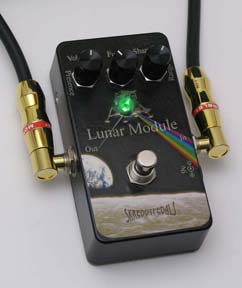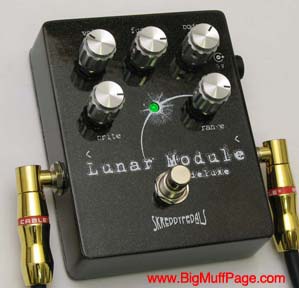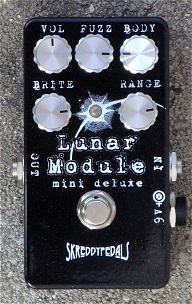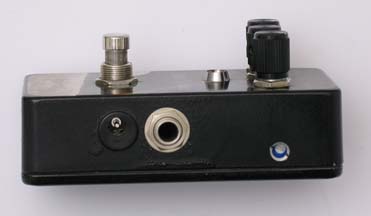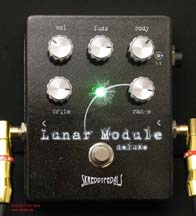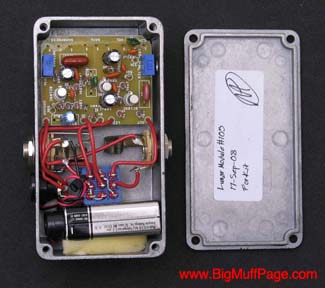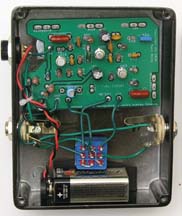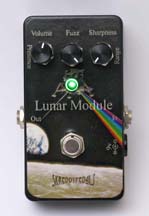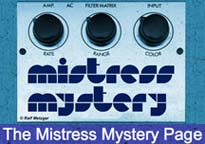Kitís Secret Guitar, Gear, and Music Page
Guitar stuff, gear stuff, soundclips, videos, Gilmour/Pink Floyd stuff, photos and other goodies.
Copyright Kit Rae.
VISIT MY SWORDS, KNIVES and FANTASY ART WEBSITE www.kitrae.net
Shown above - The original three knob Lunar Module, the five knob Lunar Module Deluxe, and the later Deluxe housed in the standard small enclosure.
SKREDDY LUNAR MODULE - The Lunar Module is a versatile Silicon based fuzz from Skreddy Pedals that was designed around the fuzz tones heard on Pink Floyd's 1973 Dark Side of the Moon album, but it really covers much more territory than that. Hand made by Marc Ahlfs in California, the LM was based around his Screwdriver overdrive pedal circuit, but with different components and values. I love tradiditonal 2 and 3 transistor Silicon fuzz pedals, so I was anxious to try this one out, and I also wanted hear how it handled some of David Gilmour's Pink Floyd tones. In the early to mid 1970s Gilmour was known to use a Silicon Fuzz Face, along with a Colorsound Power Boost, pumped into his clean Hiwatt and Fender amps. A Fuzz Face with really good BC108 transistors will get you close to those screaming fuzz tones, and the Power Boost will give you the overdrive tones. As an overdrive and a fuzz pedal hybrid, the LM does both very well, and more.
Most Fuzz Face type pedals like to go first in the signal chain, right after the guitar, due to the way they operate with the guitar pickups as a whole circuit. Drop a Fuzz Face in the middle of a pedal chain and the sound ususally changes for the worse. Buffered pedals in the chain can also react negatively to a fuzz circuit and alter the tone. I found the LM can go anywhere in my pedal chain, and the tone does not seem to be affected in a negative way by other buffered pedals. The three knob LM features Volume, Fuzz, and Sharpness/Body controls on the top panel. The Fuzz knob controls the amount of gain, like a typical fuzz. At low settings it is very much a smooth overdrive pedal, something typical fuzz pedals don't do very well. At the top of the sweep it does a very nice high gain fuzz. Not over the top screaming agressive splattiness, but a good saturated fuzz. The Sharpness/Body control adjusts the thickness and clarity of the fuzz, increasing or decreasing the bottom end of the tone body like a bass control. I found the entire pot sweep gives very usable tones, but this control also allows you to really fine tune the fuzz to work well with your particular amp tone. It is also very interactive with the trim pot cotrols. Adjusting the guitar volume down smooths out the tone into the clean light drive/rhythm area, allowing touch sensitive playing. Compared to typical fuzz pedals, touch sensitivity was good with the LM.
Shown above - Side view of the Lunar Module showing one of the user accessable trim pots mounted in the sides of the enclosure, and the Deluxe version with these trims converted to dedicated knobs on the top of the pedal
On either side of the enclosure are two adjustable trim pots, controlling Presence (left) and Range (right). The stock trim setting are around 3:00. These can be adjusted with a small screwdriver, and I found the real magic happens with these two controls. The Range trim is a pre-gain control that affects how clean or dirty/aggressive the drive is. The Presence trim is a sort of tone/presence control. Crank them up and the fuzz gets brighter and more hairy/splatty, dial down and it smooths out. They can make the low gain overdrive tones sound silky smooth, or fat and crunchy. They can take the high gain fuzz sounds into the agressive, screaming, almost out of control territory when both are set to maximum. Loads of sustain too. These trims are so usable I found myself wishing the Presence and Range had been proper knobs on top of the pedal instead of trim pots. I got my wish. Marc later made a five knob deluxe version of the LM in a larger box with all controls on top of the pedal, and I highly recommend that version. In 2012 the Deluxe was rehoused in the smaller enclosure, including all five knobs, and that is now the only version being offered. With the Deluxe, you can turn the Fuzz knob to zero and use the Body and Range knob to control the amount of drive, giving the pedal a whole different voice than with the Fuzz controlling the drive. This is where the overdrive side of the LM really shines. I like to use compressors with my distortion pedals and I found the LM did not really blend with them very well with any significant fuzz dialed in, but in general, Skreddy pedals do not seem to need any added compression anyway. With the fuzz dialed off however, a comp works perfectly with the LM. I found I could nail Pink Floyd's Another Brick in the Wall II tone easily this way.
The LM Deluxe is incredibly versatile as an overdrive or a fuzz/distortion pedal. I found it could handle the Meddle and Dark Side of the Moon fuzz tones superbly, as well as David's earlier Floyd fuzz tones, but it really works for just about anything fuzz related - Clapton, Hendrix, SRV, et cetera. I had no problem getting tones similar to a Fuzz Face or Tonebender, or even into the Colorsound Power Boost territory. As an overdrive, the LM holds it's own against any top name OD, from light, smooth drive tones, to heavy and warm SRV tones. With the Fuzz set to zero the LM can nail the Division Bell/Pulse era Pink Floyd Tube Driver tones. The controls are very interactive, so you can spend a lot of time finding settings your really like. This is probably the most usable and adjustable fuzz pedal I have ever played. It gets noisy when the gain is turned up, as do all high gain fuzz pedals, but the noise level is about average on medium gain, and above average when all knobs are set for max gain. The pedal also get noisy when the Sharpness/Contour knob is set low, for maximum bass. Power is from a 9v battery or standard Boss style AC adaptor power supply. I did not notice much difference in tone between the battery or adaptor.
Shown above - Gut shots of the Lunar Module and LM Deluxe showing the three Silicon transistors
CIRCUIT - For those interested, here is a bit of info about the circuit. Marc based the LM on his Screwdriver circuit layout. The Screwdriver started off as his attempt to combine a RangeMaster and Fuzz Face into one pedal, untimately becoming a hybrid fuzz using design elements from these, a Big Muff, Rat, and Colorsound Power Boost. The LM is a modified version of that pedal, similar to the Power Boost, but with a bass control before the Silocon distortion section instead of treble and bass controls. There is a treble control after the distortion section, a negative feedback section like a Big Muff, and a master volume like the Colorsound Overdriver. The tone filtering is very different from the Power Boost, as the LM is very smooth and warm, rather than on the bright and glassy side like the PB.
LUNAR MODULE SETTINGS - Below are some suggested settings for the Lunar Module Deluxe version, but they are also usable for the three knob version, considering these changes - the Body control on the five knob version is called Sharpness on the three knob version, the Brightness control is the left trim pot (Presence) on the three knob version, and Range is the right trim. As with any fuzz, try backing the guitar volume down a bit if there is too much drive or saturation for your taste, or to get more single note definition and touch sensitivity.
1. Smooth, medium gain Silicon fuzz - for general fuzz tones, like the Money solo
Volume - unity Fuzz - 1:00 Body/Sharpness - 1:00
Brite/Presence - 3:00 Range - 3:00
2. High gain, fat, screaming and splatty Silicon fuzz - Like the high gain Time and Echoes "funky part" solo tones
Volume - unity Fuzz - max Body/Sharpness- 7:00 Brite/Presence- max Range - max
3. Clean, chimy, power boost tones
Volume - max Fuzz - 0 Body/Sharpness- 12:00-1:00 Brite/Presence- 3:30 Range - 3:00
4. Light overdrive
Volume - unity Fuzz - 0 Body/Sharpness- 9:00-10:00 Brite/Presence- 3:00 Range - 9:00
5. Medium "tube driver" overdrive for - Coming Back to Life and Shine on You Crazy Diamond solo tones
Volume - unity Fuzz - 0 -11:00 Body/Sharpness - 11:00 Brite/Presence- max Range - 11:30-12:30
(adjust amount of drive by increasing Range or Body/Sharpness, not Fuzz)
6. Punchy light drive with a compressor - for Another Brick in the Wall II style solo tones. Also works great with a comp and chorus for the Delicate Sound of Thunder and Pulse era clean/light drive tones
Volume - unity Fuzz - 0 -11:00 Body/Sharpness - 11:30 Brite/Presence- max Range - 12:00
(adjust amount of drive by increasing Range or Body/Sharpness, not Fuzz)
Here are a few demo clips, played with a Fender American Deluxe Strat with EMG-SA neck pickup, into a '65 Fender Twin Reverb RI and Reeves Custom 50-CS. The Fuzz knob is dialed to zero, and gain/drive is adjusted by increasing the Range or Body/Sharpness.
Here are demo clips, played with a 2008 Fender American Strat with Seymour Duncan SSL-5 bridge pickup, Custom Shop '96 neck pickup, into a '65 Fender Twin Reverb RI. Delay is from an MXR Carbon Copy.
Lunar Module Sound Clip 1 - Money solo. Setting 1 above
Lunar Module Sound Clip 2 - Dark Side solo tones Setting 2 and 1 above
Lunar Module Sound Clip 3 - Bridge and neck pickup demos using setting 1 above
Lunar Module Sound Clip 4 - Noodling around with the Lunar Module. Various settings.
Lunar Module Sound Clip 5 - On an Island solo (TC Nova delay)
Here is a clip showing the guitar volume sensitivity with a moderate fuzz setting on the Lunar Module. Strat with Seymour Duncan SSL-5 bridge pickup, into a '65 Fender Twin Reverb RI and Reeves Custom 50. Delay is from a TC Nova.
Lunar Module Sound Clip - adjusting guitar volume
PINK FLOYD'S "TIME" SOLO - There is no better test for David Gilmour's Dark Side fuzz tones than the incredible solo from Pink Floyd's song Time. Here I am using the LM on a full gain fuzz setting to get the screaming, overdriven fuzz sound from the Time studio version. Settings are the same as setting 2 shown above. Both trim pots are set to maximum. Played with a 2008 Fender American Strat with Seymour Duncan SSL-5 bridge pickup into a '65 Fender Twin RI. TC Nova delay.
I paid around $170 for my LM at the time I wrote this review. There was a long wait to get it made of about four months, but it was well worth the wait, as it is with most Skreddy pedals. The cost was about average for a decent fuzz pedal, but with the full range of controls offered on the LM, it blows away many of the better two and three knob fuzz pedals out there. I highly recommend the five knob version however. It adds an extra $40 to the cost (as of 2010), but well worth it.
NOTE - I have listed the gear and settings I use in most cases, for reference, but note that the tones may not exactly match your rig, depending on which amp you use, your guitar, and pickups, and fingers.
Review written in 2008. Updated 2011












